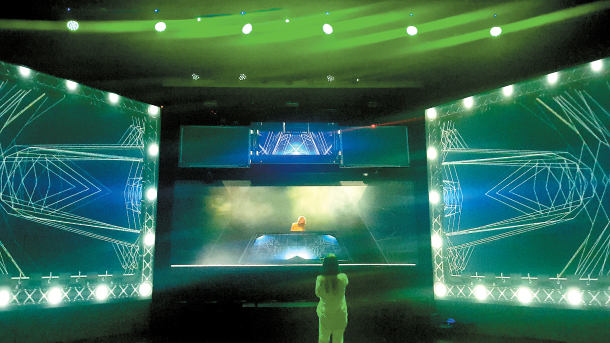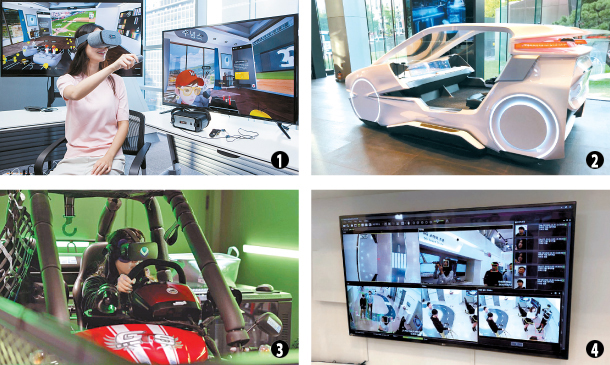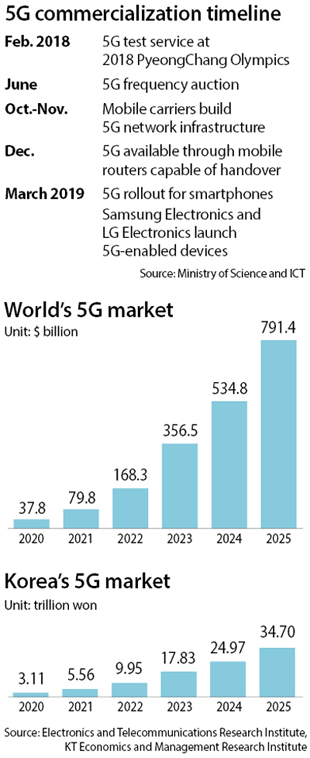[The Future is Now] None of this stuff will work without 5G

The reporter watches a hologram concert run by KT at K-Live VR Park in Sangam-dong, western Seoul on Oct. 5. [KIM JEE-HEE]
Budding romantics may soon be able to pull on their VR headset and meet up in a virtual world. They will be able to visit VR amusement parks, watch real-world sports events livestreamed in virtual stadiums or take romantic strolls along a virtual river. They might still be wearing pajamas in a messy bedroom at home, but their virtual avatars are always fully dressed in the latest fashion with makeup and hair fully prepped and ready to go.
Virtual dating is one of many futuristic scenarios that mobile carriers say could come true when 5G, a next-generation mobile network that is expected to be 20 times faster than the current 4G long term evolution (LTE) network, is commercialized.
On Friday last week, Korea’s largest mobile carrier SK Telecom launched Oksusu Social VR, a new service that offers a glimpse of the virtual world it is striving to create in the 5G era. Oksusu Social enables up to eight users to meet in a virtual room to watch sports games, concerts or movies together.
Each user entering the virtual world is given an avatar they can decorate in their own style. These avatars can talk to each other using their user’s voice or in text chats. Simply put, it’s an early version of the endless virtual worlds that until now have been the preserve of science fiction movies like Ready Player One.
This reporter tried out the service at an SK Telecom office in Seoul last week and watched a live-streamed baseball game in the virtual world with four other users. The graphics weren’t perfect, but some things, like the audio, were surprisingly accurate. The voices of closer avatars were louder than those that were further away, and sound was also directional, accurately mimicking the real world. Movement and interaction was still very limited, but the potential for the technology was obvious.
“With 5G, VR content will look more realistic and more people will be able to enjoy it at the same time like in the movie Ready Player One,” said Jeon Jin-soo, the leader of the augmented reality and VR lab at SK Telecom’s Media Technology R&D Center. “And soon, people will be able to do many things inside the virtual world.”

1. An employee from SK Telecom demonstrates Oksusu Social VR at the company’s office in Seoul on Oct. 11. 2. A futuristic car in SK Telecom’s headquarters in central Seoul shows how 5G can change the driving experience. 3. The reporter tries a virtual reality game at a VR center set up by KT, dubbed Vright, in Sinchon, western Seoul, in March. 4. A demonstration shows how surveillance could work with 5G at LG U+’s headquarters in Yongsan, central Seoul on Oct. 5. [SK TELECOM, KIM JEE-HEE]
5G refers to the fifth generation network that will succeed the current 4G network that has been prevalent for about seven years. Unlike with other technologies, generational shifts in mobile networks tend to be dramatic, and the upgrade to 5G is expected to be no exception. As a result, 5G has become almost synonymous with innovation in a lot of industries including among tech companies, mobile carriers and even carmakers.
5G will obviously be superfast. If downloading a 15-gigabyte ultra-high-definition movie takes about four minutes on 4G, it will take just six seconds on 5G, according to a report from Samsung Electronics. Companies are counting on 5G to deliver data-heavy content like VR, augmented reality and holograms fast enough for people to enjoy seamlessly.
It’s not only speed that the new network will bring to the party. Its low-latency delivery of data is very important in self-driving cars, robotic surgery and other technologies where a delay in data transfers could quite literally be a case of life or death. Today, latency is about 0.03 to 0.05 seconds on 4G, meaning a self-driving car moving at 100 kilometers per hour (62 miles per hour) would move at least 81 centimeters (31 inches) before a remote braking signal reaches the vehicle on 4G. With 5G, latency will be down to 0.001 second, or just 3 centimeters for that autonomous car.
The network is also able to handle traffic from more devices at once, which is why SK Telecom expects to be able to invite more participants to its virtual world. Carriers are aiming to connect 1 million devices at once within a 1 kilometer-square area on 5G, 10 times more than is currently possible with 4G.
“The next-generation 5G network will bring about a social and economic disruption like all other general purpose technologies such as electricity, computers and steam locomotives,” said Kim Hee-su, head of KT Economics and Management Research Institute in July.
A report from the institute says the network will generate at least 48 trillion won ($42.5 billion) worth of social and economic value by 2030, accounting for roughly 2 percent of that year’s gross domestic product by creating new business models for many industries including the automobile and surveillance industries.

Like SK Telecom, other mobile carriers are racing to create killer content and services in preparation for the 5G era.
In August, KT and its subsidiary Genie Music held a holographic concert featuring the music of legendary Korean singer-songwriter Yoo Jae-ha, who passed away in 1987, for reporters at K-Live VR Park in Sangam-dong, western Seoul.
Yoo was backed up by Sweet Sorrow, a group of three living male singers, but from afar it was hard to tell who was holographic.
When 5G takes off, live-streamed hologram concerts could become common, according to Genie Music CEO Kim Hoon-bae. He said Genie Music’s new focus will be creating visual music using the speedy network.
KT is also looking to turn a profit from immersive gaming.
In February, KT said it will focus on VR and AR content in its attempt to cash in on 5G, following the company’s successful trial of the speedy network at the PyeongChang Winter Olympic Games. The company said its target is to bring in 100 billion won from AR and VR by 2020.
In its first step toward establishing the 2020 goal, KT opened up a VR and AR gaming venue dubbed Vright in Sinchon, western Seoul, in March in partnership with GS Retail. KT’s role is to provide a 5G network and secure the latest immersive content from leading game developers. GS Retail is managing operations at the venue and will help franchise the business.
“As devices to experience immersive content at home have not widely been distributed yet, we thought these VR experience venues will be where our customers first experience the power of 5G,” said Koh Yoon-jeon, head of KT’s future business development unit.
A source from KT said last week that the company is considering releasing its own VR headset, most likely in November, to bring VR experiences to a wider audience.
According to Koh, the gaming, music and media market will jump up a level through the use of VR, AR and holograms, just as the gaming industry got a huge boost from smartphone games after LTE networks were commercialized.
LG U+ is also on the move.
At the beginning of this year, LG U+ showed off six major services the carrier hopes to offer customers with the new network at its 5G experience zone set up in its Yongsan headquarters in central Seoul. The services include intelligence surveillance, immersive media and drones.
A CCTV camera installed in the 5G experience zone recognizes people’s age and sex as they enter, though age has now been removed after embarrassed customers complained. If anyone on a company’s blacklist made it into the building, the intelligent CCTV system would immediately give alerts. The CCTV will be able to read emotions on people’s face and monitor whether there is any intrusion or violence. According to the company, 5G will enable the CCTV to analyze footage of a constantly moving crowd in real-time.
“Though we don’t make the cameras ourselves, we plan to make security systems, camera and networks into a package when selling the service to customers,” a spokesperson from LG U+ said.
As for media content, LG U+ is preparing a VR service that lets users watch the biggest K-pop stars perform as if they were together with them on stage.
The Ministry of Science and ICT, hoping for Korea to become the first country to commercialize the 5G network for smartphones, is also pursuing a three-year project to find business models in areas where the new network will be of great use.
The government highlighted five areas - self-driving, smart factories, smart cities, disaster relief and immersive media - this year as areas with large business potential and said it will inject 86.3 billion won into those sectors so that companies can establish effective business models by 2020.

The Ministry of Science and ICT said 5G will be commercialized simultaneously by all three local carriers - SK Telecom, KT and LG U+ - in March next year, though the first 5G airwaves will be available for use from December this year at the earliest through mobile routers. In the U.S., Verizon has already started offering 5G services for home internet users in four cities from this month, but the Korean government still believes it has a chance to become the first to commercialize 5G for smartphones.
After the 5G frequency auction ended in June, Korea’s three carriers are busy choosing equipment partners to establish a 5G network infrastructure. Industry insiders expected carriers to team up with equipment makers by last month, but they haven’t all made decisions yet and that is delaying them from setting up infrastructure.
Whether to involve Huawei equipment, considered cheaper and competitive, like LG U+ did when establishing a 4G network has been a major issue. Huawei is accused of being a security risk as some countries have already claimed that the Chinese company’s equipment could be used for spying. The Australian government banned Huawei and another Chinese company ZTE from supplying 5G wireless equipment to its mobile carriers in August, while the U.S. government has also banned the companies from use in the public sector.
SK Telecom has already announced that it will not include Huawei in its preferred partners. It chose to work with Samsung Electronics, Nokia and Ericsson.
Following the announcement, Huawei insisted it carries no espionage risk and said it is doing its best to offer stringent cyber security in a statement last week, but concerns remain and the two other carriers have still not revealed their choices.
Despite the delays, Jun Sung-bae, an assistant minister at the Science Ministry, said there is no change to the 5G commercialization timeline already announced.
Serious hardware required
Even if the network is ready on time, devices also need to be ready for consumers to actually use the highly-anticipated network.
Samsung Electronics said in August that it plans to launch a 5G-enabled phone by next March, but the electronics giant has since confirmed that its upcoming Galaxy S10 will not be that phone. Despite Samsung’s statement, speculation has continued that there will be a 5G-enabled verstion of the S10.
LG Electronics said it will release 5G smartphones in the U.S. by the first half of next year in partnership with U.S. mobile carrier Sprint. In a recent press event for the introduction of its V40 smartphone, Hwang Jeong-hwan, head of LG’s mobile business, hinted that next year it will likely focus on 5G-enabled and foldable devices, but declined to give details.
While U.S. carrier Verizon and Motorola introduced the Moto Z3, which they say is the first 5G-capable phone, in August, it doesn’t offer superfast connections yet as 5G still doesn’t practically exist. When the high-speed network does become a reality, there will be an add-on module for the Z3 to make it work on 5G.
Market tracker Strategy Analytics projected in March that while the first 5G handsets will go on sale from early 2019, sales will not begin to scale up until 2021 as only a handful of 5G devices will be available at high prices and the new network will only initially cover some urban areas.
“By 2021, 5G networks in key countries in Asia and North America will cover many urban centers, giving customers a reason to purchase 5G smartphones,” says Ken Hyers, director at Strategy Analytics. “By 2023, as 5G smartphone prices continue to fall and next-generation wireless networks are built out across much of the developed world, 5G handset sales will number in the hundreds of millions.”
BY KIM JEE-HEE [kim.jeehee@joongang.co.kr]










with the Korea JoongAng Daily
To write comments, please log in to one of the accounts.
Standards Board Policy (0/250자)